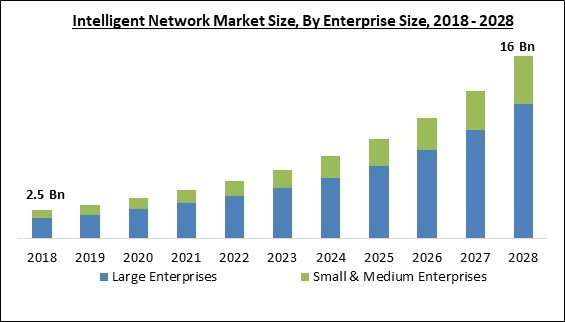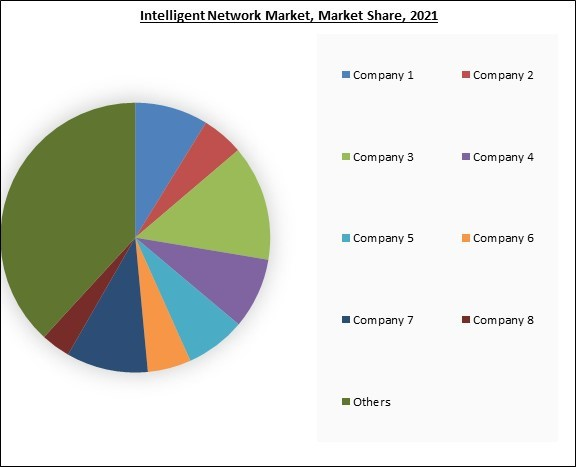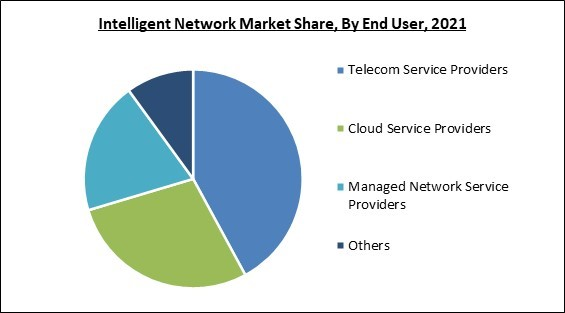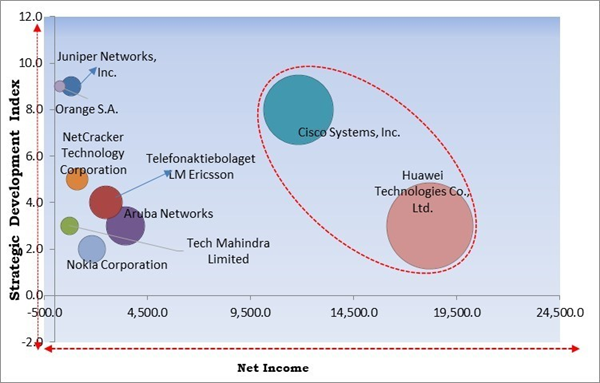The Global Intelligent Network Market size is expected to reach $16 billion by 2028, rising at a market growth of 21.1% CAGR during the forecast period.
A telecommunications network architecture known as an intelligent network (IN)enables higher service integration and automation levels, allowing carriers to offer value-added services (VAS)to their consumers. The network's performance, dependability, and scalability are all improved through the application of cutting-edge technology like artificial intelligence (AI)and machine learning (ML). As a result, service providers can provide tailored services, streamline network administration, and cut costs by utilizing IN.
As a result, the consumer experience is enhanced, and the service providers have more options to earn money. The recommended ITU-T Q.1200 series standard network architecture is the intelligent network (IN). It is designed for use with both fixed and mobile telecom networks. Offering value-added services alongside conventional telecom services like ISDN, PSTN on fixed networks, and GSM on cellular phones or similar mobile devices enables operators to distinguish from the competition.
In contrast to approaches based on core switchintelligence or equipment, network nodes on the core network'sservice layer - as opposed to the switching layer - provide the intelligence. The majority of the time, telecom service providers like phone companies or mobile phone operators are the ones who own the IN nodes. In communication between network switching hubs and other network nodes operated by network operators, IN is provided by the Signaling System #7 (SS7) protocol. This technology is used by numerous systems that have been implemented worldwide. With new services being added regularly, the architecture has shown to be reliable and a consistent source of income.
The leading players in the market are competing with diverse innovative offerings to remain competitive in the market. The below illustration shows the percentage of revenue shared by some of the leading companies in the market. The leading players of the market are adopting various strategies in order to cater demand coming from the different industries. The key developmental strategies in the market are Acquisitions, and Partnerships & Collaborations.
The major strategies followed by the market participants are Product Launches. Based on the Analysis presented in the Cardinal matrix; Cisco Systems, Inc. and Huawei Technologies Co., Ltd. are the forerunners in the Intelligent Network Market. Companies such as Aruba Networks, NetCracker Technology Corporation and Nokia Corporation are some of the key innovators in Intelligent Network Market.
The market research report covers the analysis of key stake holders of the market. Key companies profiled in the report include Orange S.A., Tech Mahindra Limited, Juniper Networks, Inc., Nokia Corporation, Cisco Systems, Inc., Huawei Technologies Co., Ltd. (Huawei Investment & Holding Co., Ltd.), NetCracker Technology Corporation (NEC Corporation), Telefonaktiebolaget LM Ericsson, Aruba Networks (Hewlett Packard Enterprise Company) and Colt Technology Services Group Limited.
A telecommunications network architecture known as an intelligent network (IN)enables higher service integration and automation levels, allowing carriers to offer value-added services (VAS)to their consumers. The network's performance, dependability, and scalability are all improved through the application of cutting-edge technology like artificial intelligence (AI)and machine learning (ML). As a result, service providers can provide tailored services, streamline network administration, and cut costs by utilizing IN.
As a result, the consumer experience is enhanced, and the service providers have more options to earn money. The recommended ITU-T Q.1200 series standard network architecture is the intelligent network (IN). It is designed for use with both fixed and mobile telecom networks. Offering value-added services alongside conventional telecom services like ISDN, PSTN on fixed networks, and GSM on cellular phones or similar mobile devices enables operators to distinguish from the competition.
In contrast to approaches based on core switchintelligence or equipment, network nodes on the core network'sservice layer - as opposed to the switching layer - provide the intelligence. The majority of the time, telecom service providers like phone companies or mobile phone operators are the ones who own the IN nodes. In communication between network switching hubs and other network nodes operated by network operators, IN is provided by the Signaling System #7 (SS7) protocol. This technology is used by numerous systems that have been implemented worldwide. With new services being added regularly, the architecture has shown to be reliable and a consistent source of income.
COVID-19 Impact Analysis
COVID-19 had a favorable effect on the market for intelligent networks. This is due to the expansion of 5G deployment and end users' widespread use of intelligent network solutions to maintain business continuity worldwide. Due to the COVID-19pandemic, whichcaused millions of people to live in isolation, reliable internet connection becameessential for enabling people to work from home without having to travel to an office. Owing to the pandemic, the governmentput in place blockades to stop the virus's spread. Still, these restrictions caused many businesses to go online and increased the adoption of digital services globally. As a result, thedemand for intelligent network solutions arose, which propelledmarket expansion.Market Growth Factors
Advancement of technologies like artificial intelligence as well as machine learning
Intelligent networks can deliver real-time network data that helps identify and fix network problems, enhancing network performance and decreasing downtime. Moreover, artificial intelligence and machine learningalgorithms can instantly identify and stop security threats, enhancing network security and lowering the chance of security breaches. As a result, the incorporation of artificial intelligence and machine learninginto intelligent networks enables better network performance, as well as the delivery of brand-new, cutting-edge services to clients. The market for intelligent networks is expanding as a result of these innovations.The leading players in the market are competing with diverse innovative offerings to remain competitive in the market. The below illustration shows the percentage of revenue shared by some of the leading companies in the market. The leading players of the market are adopting various strategies in order to cater demand coming from the different industries. The key developmental strategies in the market are Acquisitions, and Partnerships & Collaborations.
Implementation of 5G networks on a large scale
An important opportunity for the market for intelligent networks is the broad adoption of 5G networks. The advantages of 5G networks over older generations of wireless networks include faster speeds, lower latency, as well as support for cutting-edge services, and the use of applications like the internet of things (IoT) and virtual reality. As 5G networks are implemented, there will be greater demand for intelligent network technologies to support the brand-new, intricate network infrastructure that 5G calls for. Operators can enhance customer experience, optimize network performance, and decrease downtime due to intelligent networks. This supports the growth of the regional market.Market Restraining Factors
Limited data capabilities and high deployment costs
Since business models evolve quickly due to COVID-19, HR directors are pressuredto reevaluate skill requirements. For this cohort, identifying and obtaining their organization's digital capabilities to enable digital transformation, as envisaged post-COVID-19, is no easy task. In order to succeed with transformation, technology skills must now be marbledthroughout organizational departments and businesses. In addition, soft skills must also be added. Because of this, the development of the market is anticipated to be constrained by a lack of knowledge and capabilities in AI-based networking, along with high deployment costs.Application Outlook
Based on application, the intelligent network market is categorized into information cognition, traffic prediction & classification, resource management & network adoption, and performance prediction & configuration extrapolation. The traffic prediction and classification segment procured a considerable growth rate in the intelligent network market in 2021. Its use as a tool for resource management, network threat detection, and network service quality improvement accounts for the segment's expansion. Service optimization, cyberspace governance,and the elimination of cyber risks all depend on understanding how network systems are used and how they function.Enterprise Size Outlook
On the basis of enterprise size, the intelligent network market is divided into large enterprises and small & medium enterprises. The large enterprises segment acquired the largest revenue share in the intelligent network market in 2021. Large enterprises now disseminate their data and applications over numerous data centers, clouds, and edge environments. To meet the demands of this fragmented hybrid ICT ecosystem, organizations need new networking architecture that is ready for the cloud, satisfies application connectivity requirements, and maintains technical and operational consistency across sites.End-user Outlook
Based on end user, the intelligent network market is segmented into telecom service providers, cloud service providers, managed network service providers, and others. The telecom service providers segment witnessed the maximum revenue share in the intelligent network market in 2021. Network re-segmentation is utilized to accommodate increased capacity demand. However, this leads to node splitting that consumes timeand pricey on-site network device changes. More network capacity is required when subscribers increase, and new services are provided.Regional Outlook
On the basis of region, the intelligent network market is analyzed across North America, Europe, Asia Pacific, and LAMEA. The North America segment procured the highest revenue share in the intelligent network market in 2021. This is related to the existence of market participants who provide best-in-class network technology and services. Also, expanding IoT devices and 5G networksacross the region promotes the demand for IN. The market for intelligent networks in North America is expanding primarily due to the increasing deployment of network equipment andnetwork security solutions.The Cardinal Matrix - Intelligent Network Market Competition Analysis
The major strategies followed by the market participants are Product Launches. Based on the Analysis presented in the Cardinal matrix; Cisco Systems, Inc. and Huawei Technologies Co., Ltd. are the forerunners in the Intelligent Network Market. Companies such as Aruba Networks, NetCracker Technology Corporation and Nokia Corporation are some of the key innovators in Intelligent Network Market.
The market research report covers the analysis of key stake holders of the market. Key companies profiled in the report include Orange S.A., Tech Mahindra Limited, Juniper Networks, Inc., Nokia Corporation, Cisco Systems, Inc., Huawei Technologies Co., Ltd. (Huawei Investment & Holding Co., Ltd.), NetCracker Technology Corporation (NEC Corporation), Telefonaktiebolaget LM Ericsson, Aruba Networks (Hewlett Packard Enterprise Company) and Colt Technology Services Group Limited.
Strategies Deployed in Intelligent Network Market
Partnerships, Collaborations and Agreements:
- Sep-2022: Orange partnered with Netskope, a company providing data security software. This partnership would allow the company to provide consistent internet security services. Additionally, this would shield the customers from sophisticated threats and data loss across web and cloud applications with full details of the cloud-native platform.
- Feb-2022: Nokia came into partnership with Kyndryl, a company engaged in providing large-scale information systems. This partnership would allow more organizations to accelerate the digitalization journey, transform operations and take advantage of Industry 4.0.
- Mar-2020: Netcracker partnered with Google Cloud, a company providing cloud computing services. Through this partnership, the company would help customers on the next stage of digital transformation by focusing on superior customer experience and service innovation.
Product Launches and Product Expansions:
- Feb-2023: Orange collaborated with Ericsson to launch a commercial 5G Standalone network in markets of Spain. Ericsson is a company providing communication-based software solutions. Through the launch of these services, the customers would be benefitted from the technology’ including efficient appliance energy usage, indoor 5G coverage and the latest security features.
- Feb-2023: Huawei released Digital Managed Network Solution. The launched solution would assist the carriers in grabbing digital transformation opportunities and promoting growth. Additionally, this would deliver rich product portfolios and digitally managed network capabilities to help carriers shift from ISPs to MSPs.
- Feb-2023: Tech Mahindra unveiled SANDSTORM, a Smart Device Assurance Service developed for Enterprises and Telecoms. The product would change the way enterprises and telecos monitor their devices and network. Additionally, the product would allow customers to set up, gain valuable insights and run applications that were difficult previously.
- Nov-2022: Netcracker Technology unveiled Netcracker Fiber Cloud Solution. The product would provide wholesale Fiber Operators with an open and lean IT environment based on efficiency, business growth and agility. Moreover, this would provide an automated and open IT environment by integrating wholesale BSS functions and cloud-native OSS into a pre-integrated solution to target the fibre market.
- Jul-2022: Juniper Networks unveiled the EX4100 series of enterprise-grade wired access switches. The product would add to the company's value of campus and branch environments and double down Juniper’s AI-driven advantages throughout the network lifecycle.
- Mar-2022: Aruba added new features in Aruba ESP to allow enterprises to be in line with the fast transformation of business requirements. These new features would permit enterprises to consolidate the distributed networks with cloud-native services that facilitate in automating network configurations in WAN, wired and wireless infrastructures.
Acquisition and Mergers:
- Jul-2022: Ericsson completed the acquisition of Vonage, a company engaged in providing communications related in software solutions. This acquisition would provide the company access to building blocks to deliver a suite of communications solutions such as UCaaS, CCaaS and CPaaS.
- Feb-2022: Juniper Networks acquires WiteSand, a software development company based in California. This acquisition would bring exceptional technology and an experienced engineering team to Juniper. Additionally, this would add to the efforts of the company to provide advanced NAC solutions as an important element for their AI-based enterprise portfolio.
- Jun-2021: Cisco took over Kenna Security, a company providing network security solutions. Through this acquisition, the company's customers would be able to solve crucial safety posture challenges by operating cross-functionally to quickly automate the prioritization, identification and prediction of cybersecurity threats.'
- Feb-2021: Cisco completed the acquisition of IMImobile PLC, a company providing cloud communications software and services. This acquisition would deliver meaningful customer experiences throughout the life cycle by leveraging technology such as omnichannel capabilities, programmability for customization, experience management and artificial intelligence.
Scope of the Study
By Enterprise Size
- Large Enterprises
- Small & Medium Enterprises
By Application
- Information Cognition
- Traffic Prediction & Classification
- Resource Management & Network Adoption
- Performance Prediction & Configuration Extrapolation
By End-user
- Telecom Service Providers
- Cloud Service Providers
- Managed Network Service Providers
- Others
By Geography
- North America
- US
- Canada
- Mexico
- Rest of North America
- Europe
- Germany
- UK
- France
- Russia
- Spain
- Italy
- Rest of Europe
- Asia Pacific
- China
- Japan
- India
- South Korea
- Singapore
- Malaysia
- Rest of Asia Pacific
- LAMEA
- Brazil
- Argentina
- UAE
- Saudi Arabia
- South Africa
- Nigeria
- Rest of LAMEA
Key Market Players
List of Companies Profiled in the Report:
- Orange S.A.
- Tech Mahindra Limited
- Juniper Networks, Inc.
- Nokia Corporation
- Cisco Systems, Inc.
- Huawei Technologies Co., Ltd. (Huawei Investment & Holding Co., Ltd.)
- NetCracker Technology Corporation (NEC Corporation)
- Telefonaktiebolaget LM Ericsson
- Aruba Networks (Hewlett Packard Enterprise Company)
- Colt Technology Services Group Limited
Unique Offerings
- Exhaustive coverage
- The highest number of Market tables and figures
- Subscription-based model available
- Guaranteed best price
- Assured post sales research support with 10% customization free
Table of Contents
Chapter 1. Market Scope & Methodology
Chapter 2. Market Overview
Chapter 3. Competition Analysis - Global
Chapter 4. Global Intelligent Network Market by Enterprise Size
Chapter 5. Global Intelligent Network Market by Application
Chapter 6. Global Intelligent Network Market by End-user
Chapter 7. Global Intelligent Network Market by Region
Chapter 8. Company Profiles
Companies Mentioned
- Orange S.A.
- Tech Mahindra Limited
- Juniper Networks, Inc.
- Nokia Corporation
- Cisco Systems, Inc.
- Huawei Technologies Co., Ltd. (Huawei Investment & Holding Co., Ltd.)
- NetCracker Technology Corporation (NEC Corporation)
- Telefonaktiebolaget LM Ericsson
- Aruba Networks (Hewlett Packard Enterprise Company)
- Colt Technology Services Group Limited
Methodology

LOADING...












